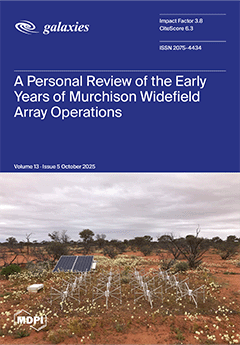The formation and evolution of galaxies and other astrophysical objects have become of great interest, especially since the launch of the James Webb Space Telescope in 2021. The mass, size, and density of objects in the early universe appear to be drastically different
[...] Read more.
The formation and evolution of galaxies and other astrophysical objects have become of great interest, especially since the launch of the James Webb Space Telescope in 2021. The mass, size, and density of objects in the early universe appear to be drastically different from those predicted by the standard cosmology—the
CDM model. This work shows that the mass–size–density evolution is not surprising when we use the CCC+TL cosmology, which is based on the concepts of covarying coupling constants in an expanding universe and the tired light effect contributing to the observed redshift. This model is consistent with supernovae Pantheon+ data, the angular size of the cosmic dawn galaxies, BAO, CMB sound horizon, galaxy formation time scales, time dilation, galaxy rotation curves, etc., and does not have the coincidence problem. The effective radii
of the objects are larger in the new model by
. Thus, the object size evolution in different studies, estimated as
with
±
, is modified to
, the dynamical mass by
and number density by
. The luminosity modification increases slowly with
to 1.8 at
. Thus, the stellar mass increase is modest, and the luminosity and stellar density decrease are mainly due to the larger object size in the new model. Since the aging of the universe is stretched in the new model, its temporal evolution is much slower (e.g., at
, the age is about a dex longer); stars, black holes, and galaxies do not have to form at unrealistic rates.
Full article





